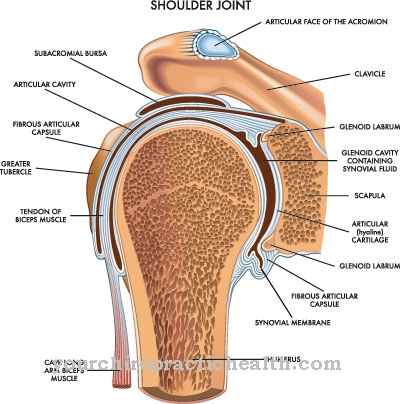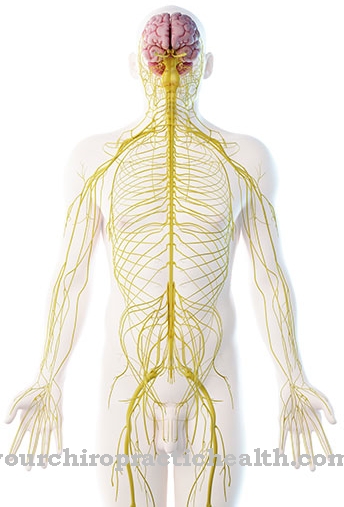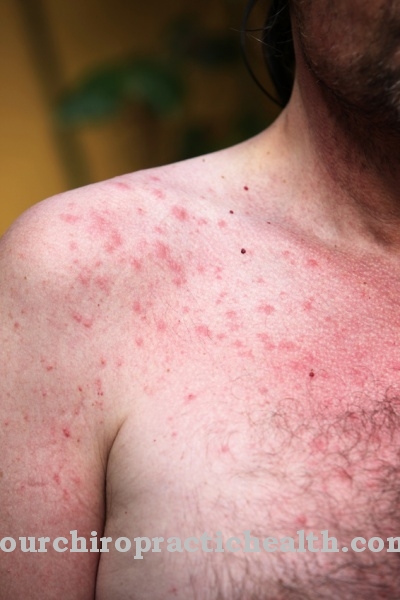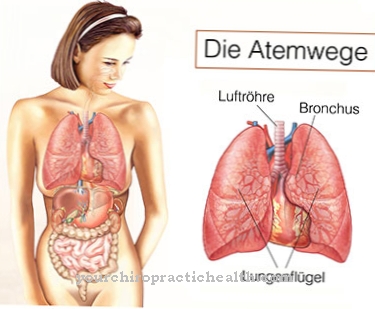Of the Heel foot (Pes calcaneus) is a relatively common misalignment in which the foot is bent upwards so much that the toes can touch the shin with light pressure and the heel is the lowest point. There are two forms of the hoof foot, congenital and acquired.
What is a hook foot?

© Sebastian Kaulitzki - stock.adobe.com
With the heel foot, the foot is straight up, standing on the sole of the foot is not possible. You can only stand on your heel with a heel foot. The sole of the foot is turned slightly outwards.
Excessive upward flexion, especially in infants with the innate shape of the heel foot, allows the back of the foot to move up to the shin. The Achilles tendon is severely overstretched and slackened due to this incorrect posture.
The tendons and skin on the back of the foot, on the other hand, are shortened. This form of misalignment is the opposite of equinus foot, in which the foot is overstretched and not the heel but the toes point down.
causes
The hook foot can have different causes, depending on whether it is congenital or acquired. The innate form can arise from a genetic muscle imbalance.
The hook foot also occurs in certain diseases of the spinal cord, such as spina bifida or in damage to the brain, such as is caused by hypoxia (lack of oxygen). Another possible cause of the pusopus is an unfavorable position of the embryo in the uterus.
If the foot does not have enough space and is forcibly bent upwards, a heel is created. However, this form regresses well in the first few weeks of life.
The acquired hoe foot occurs when the muscles of the calf are disturbed in their function. This can happen through injuries to the tibial nerve or the Achilles tendon. An incorrectly applied plaster cast can also cause a hook foot.
Symptoms, ailments & signs
In the case of a heel, the heel is bent upwards, so that those affected have to walk almost exclusively on the heel, which is extremely stressful and leads to pressure points. Due to the misalignment, the foot is overstretched and it is hardly possible to put it on the floor while walking. It can only be stretched to a very limited extent and standing on your toes is almost impossible.
The misalignment can sometimes be so severe that the back of the foot can touch the lower leg. Children born with hoe feet have difficulty learning to walk and the deformity of the feet means they learn to walk late. Because the foot cannot be put on properly, there is a permanent malposition when walking, in which the knee and hip joints are bent and the pelvis is tilted significantly.
Due to this faulty way of walking, the hoe foot increasingly stresses the statics of the entire skeleton. There is pain in the heel because it is chronically overloaded when walking and standing. The permanent pressure on the heel tissue can lead to pressure necrosis because the oxygen supply to the tissue is impaired by the constant pressure.
Diagnosis & course
The hook foot can be clearly diagnosed by its appearance. The foot, which is strongly bent upwards, and the outward rotation of the sole of the foot give it its typical appearance. With an X-ray, the doctor can depict the misalignment of the foot and determine any effects on the rest of the skeleton.
In the newborn, the hook foot recedes by itself within a few days if it was caused by a constrained position in the uterus. If this misalignment exists in adults, for example due to an injury to the shin nerve, it is no longer possible for him to bring his toes on the ground. Walking takes place on the heels, which leads to an overload of the heel tissue.
In the long run pain occurs, walking is difficult or impossible, depending on the severity of the deformity. The posture changes with the heel, as those affected can no longer perform the normal movements while walking.
This can lead to a tilting of the pelvis, accompanied by an increasingly strong hollow back. The constant pressure on the heels can inflame the tissue and die over time (pressure necrosis).
Complications
The heel foot leads to a very bad position in the foot. This misalignment leads to various complaints when walking and standing and usually also leads to relatively severe pain. The misalignment also causes other complaints with the Zeus, such as the so-called hollow back.
Due to the restricted mobility and the permanent pain, many patients also suffer from psychological complaints or from depression. It can also lead to slight irritability. Children can also be teased or bullied because of the illness. Treatment of the disease is symptomatic and causal.
The pain can be limited with the help of pain relievers, without complications. However, long-term use of pain relievers can also damage the stomach. Furthermore, the heel foot can also be corrected relatively easily.
In most cases, however, various therapies are still necessary to completely limit the symptoms. There are no further complications or complaints during treatment. As a rule, the troubles of the hook foot no longer occur in adulthood. The life expectancy of the patient is also not reduced by the disease.
When should you go to the doctor?
In most cases, hook foot is congenital and is diagnosed in infants right after birth. It can be caused by an unfavorable position in the womb during pregnancy or it can be genetically predisposed. Often it is a temporary deformity that regulates itself after a few days.
A hoe foot can also later be caused by an injury, e.g. B. a tear in the Achilles tendon. In the case of a severe deformity that causes pain and pressure points and makes walking difficult, a doctor should be consulted. He can usually tell the reason from the type of deformity and the discomfort it causes. In addition, an X-ray can provide more detailed information about the cause.
If the foot does not return to the correct position on its own, the doctor can prescribe physiotherapeutic measures; in rarer cases, surgery must be carried out to correct the misalignment. Since a hoe foot can cause further complaints in the musculoskeletal system due to poor posture, those affected should consult a doctor as early as possible so that corrective measures can be initiated in good time.
Doctors & therapists in your area
Treatment & Therapy
Therapy is based on the cause. The hook foot, which arose in the newborn as a result of being too tight in the uterus, can be treated easily. As a rule, it almost resolves itself.
The treatment to be performed here only has a supporting effect on the foot by repeatedly bringing it into the correct position with gentle pressure massages, holding it for a few seconds and then letting it go again. If the hook foot is stronger, it may be necessary to hold it in the correct position with splints during the night.
Physiotherapeutic measures can support the regression. An operation may be necessary if the phalanx is acquired. A wedge is cut out of the heel bone and the misalignment is corrected. Another possible surgical therapy is shortening the Achilles tendon or stiffening the ankle.
Outlook & forecast
A heel foot is a misalignment of the foot, whereby the foot is constantly bent upwards. The entire heel bone stands steeply in a kind of extension of the lower leg. In addition, there is often a kink in the heel that points outwards. It is very difficult to give a specific prognosis for an existing hoe foot, as this clinical picture can occur in different degrees of severity.
In general, the prognosis for a hoe foot is positive, as physiotherapy or surgery can bring about an improvement. Such a hook foot is very common in newborns. However, one does not speak of an explicit clinical picture. This symptom usually disappears within a few days, so that no appropriate treatment needs to be initiated.
Anyone who decides against a treatment must expect considerable complications. In the course of old age, permanent consequential damage to the joints can occur.
prevention
You cannot prevent the congenital hook foot because it is genetic or caused by the tightness of space in the uterus. In order to prevent the acupuncture foot acquired, attention should be paid to the correct position of the foot after accidents when the leg has to be immobilized with a bandage or a cast. If the hook foot has formed, it should be treated as soon as possible to prevent further damage.
Aftercare
In most cases, those affected have no special or direct measures and options for follow-up care. In the case of this disease, early detection and diagnosis of the disease must take place so that there are no further symptoms or further complications. The earlier the disease is recognized, the better the further course of the disease will usually be.
The disease is usually treated by wearing a splint or by wearing insoles. The person concerned should make sure to use these aids permanently so that the heel foot disappears completely. Physiotherapy or physiotherapy measures can also be very helpful in the case of hoe feet and permanently alleviate the symptoms.
Often, the exercises from physiotherapy can also be carried out in your own home in order to accelerate healing. If the heel foot should be corrected by a surgical procedure, the affected person should protect the foot after the procedure and not exert himself.
Physical and stressful activities should also be avoided. As a rule, heel foot does not reduce the life expectancy of the person affected. Further follow-up measures are not necessary.
You can do that yourself
A congenital hook foot usually resolves on its own within a few days. In all other cases, the malalignment of the foot must be treated therapeutically. The treatment can be effectively supported by a few measures.
In addition to physiotherapy treatment, targeted foot training is recommended to strengthen the flexors of the feet and toes. Gentle pressure massages are just as effective and help especially with a light heel foot. Severely pronounced misalignments may have to be corrected with the help of splints or plaster casts - sometimes only at night. If it is not possible to correct the heel foot sufficiently, wearing orthopedic shoes with insoles is indicated.
In adolescents and adults, surgical treatment is necessary, especially in the case of an accidental hoe foot. After the surgical procedure, strict bed rest and rest applies to those affected. The affected foot must be slowly prepared for everyday stress with the help of physiotherapy or light exercise. It makes sense to wear orthopedic insoles in the first days to weeks after the operation. The doctor in charge must decide in any case which measures those affected can take on their own.






.jpg)






.jpg)

.jpg)
.jpg)











.jpg)